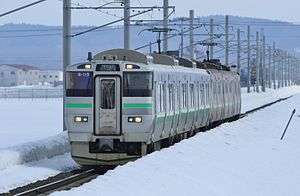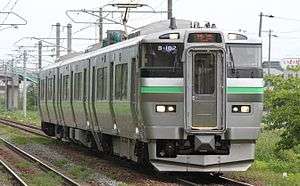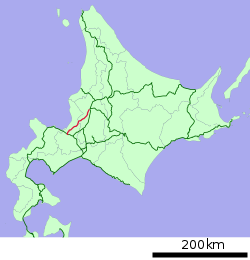Sasshō Line
The Sasshō Line (札沼線, Sasshō-sen) is a railway line in Japan operated by Hokkaido Railway Company (JR Hokkaido), which connects Sōen in Sapporo and Hokkaidō-Iryōdaigaku in Ishikari District. Its name is made up of two characters from Sapporo (札幌) and Ishikari-Numata (石狩沼田), the letter of which was the terminus of the line until it was relocated to Shin-Totsukawa in 1972.
| Sasshō Line | |||
|---|---|---|---|
 733 series 3-car set B-115 running in multiple with a 731 series set on the Sasshō Line, March 2014 | |||
| Overview | |||
| Other name(s) | Gakuentoshi Line | ||
| Native name | 札沼線 | ||
| Locale | Hokkaido | ||
| Termini | Sōen Hokkaidō-Iryōdaigaku | ||
| Line number | G | ||
| Operation | |||
| Opened | 1931 | ||
| Closed | 17 April 2020 (Hokkaidō-Iryōdaigaku – Shin-Totsukawa) | ||
| Owner | JR Hokkaido | ||
| Events | |||
| Electrified | 2012 (Sōen – Hokkaidō-Iryōdaigaku) | ||
| Technical | |||
| Line length | 28.9 km (18.0 mi) | ||
| Number of tracks | 2 (Sōen – Ainosato-Kyōikudai) | ||
| Track gauge | 1,067 mm (3 ft 6 in) | ||
| Electrification | 20 kV AC overhead line | ||
| Operating speed | 85 km/h | ||
| |||
On 19 November 2016, JR Hokkaido's president announced plans to further rationalise the network by up to 1,237 km, or ~50% of the current network,[1]. The non-electrified section of the Line was permanently closed on 17 April 2020.
Stations
| No. | Name | Japanese | Between (km) |
Distance (km) |
Transfers | Location |
|---|---|---|---|---|---|---|
| Sapporo to Sōen: officially Hakodate Main Line | ||||||
| 01 | Sapporo | 札幌 | (-1.6) |
|
Kita-ku, Sapporo | |
| S02 | Sōen | 桑園 | 1.6 | 0.0 | ■ Hakodate Main Line (for Otaru) | Chūō-ku, Sapporo |
| Sasshō Line ↓ Electrified section | ||||||
| G03 | Hachiken | 八軒 | 2.2 | 2.2 | Nishi-ku, Sapporo | |
| G04 | Shinkawa | 新川 | 1.5 | 3.7 | Kita-ku, Sapporo | |
| G05 | Shin-Kotoni | 新琴似 | 1.9 | 5.6 | ||
| G06 | Taihei | 太平 | 1.7 | 7.3 | ||
| G07 | Yurigahara | 百合が原 | 1.3 | 8.6 | ||
| G08 | Shinoro | 篠路 | 1.6 | 10.2 | ||
| G09 | Takuhoku | 拓北 | 2.0 | 12.2 | ||
| G10 | Ainosato-Kyōikudai | あいの里教育大 | 1.4 | 13.6 | ||
| G11 | Ainosato-kōen | あいの里公園 | 1.5 | 15.1 | ||
| G12 | Ishikari-Futomi | 石狩太美 | 4.2 | 19.3 | Tōbetsu, Ishikari District | |
| G13 | Ishikari-Tōbetsu | 石狩当別 | 6.6 | 25.9 | ||
| G14 | Hokkaidō-Iryōdaigaku | 北海道医療大学 | 3.0 | 28.9 | ||
Closed section
| No. | Name | Japanese | Between (km) |
Distance (km) |
Transfers | Location |
|---|---|---|---|---|---|---|
| ↓ Unelectrified section | ||||||
| Ishikari-Kanazawa | 石狩金沢 | 2.2 | 31.1 | Tōbetsu Ishikari District | ||
| Moto-Nakagoya | 本中小屋 | 4.5 | 35.6 | |||
| Nakagoya | 中小屋 | 3.2 | 38.8 | |||
| Tsukigaoka | 月ヶ岡 | 2.8 | 41.6 | Tsukigata, Kabato District | ||
| Chiraiotsu | 知来乙 | 2.6 | 44.2 | |||
| Ishikari-Tsukigata | 石狩月形 | 2.1 | 46.3 | |||
| Toyogaoka | 豊ヶ岡 | 4.7 | 51.0 | |||
| Sappinai | 札比内 | 2.5 | 53.5 | |||
| Osokinai | 晩生内 | 4.5 | 58.0 | Urausu, Kabato District | ||
| Satteki | 札的 | 2.9 | 60.9 | |||
| Urausu | 浦臼 | 1.8 | 62.7 | |||
| Tsurunuma | 鶴沼 | 3.4 | 66.1 | |||
| Osatsunai | 於札内 | 1.8 | 67.9 | |||
| Minami-Shimo-Toppu | 南下徳富 | 1.5 | 69.4 | Shintotsukawa, Kabato District | ||
| Shimo-Toppu | 下徳富 | 2.1 | 71.5 | |||
| Shin-Totsukawa | 新十津川 | 5.0 | 76.5 | |||
Rolling stock
As of April 2020, the following electric multiple unit (EMU) rolling stock is used on the Sasshō Line.
- 721 series EMUs (since 1 June 2012)[2]
- 731 series EMUs (since 1 June 2012)[2]
- 733 series EMUs (since 1 June 2012)[2]
- 735 series EMUs (since 1 June 2012)[2]
 721 series EMU, July 2006
721 series EMU, July 2006 731 series EMU, March 2008
731 series EMU, March 2008 733 series EMU, June 2012
733 series EMU, June 2012 735 series EMU, May 2012
735 series EMU, May 2012
Former rolling stock
Prior to the 27 October 2012 timetable revision, the following diesel multiple unit (DMU) and EMU rolling stock was used on the Sasshō Line.[2]
- KiHa 40 series DMUs
- KiHa 141 series DMUs
- KiHa 201 series DMUs
- 711 series EMUs
- KiHa 40 series DMU
- KiHa 141 series DMU, January 2010
- KiHa 201 series DMU, January 2010
- 711 series EMU, January 2009
History
The first part of the line to open was the northern (and now closed) section between Ishikari-Numata (on the Rumoi Main Line) to Nakatoppu (present-day Shin-Totsukawa). This opened on 10 October 1931, and was initially named the Sasshō North Line (札沼北線, Sasshō-hoku-sen).[3] This line was extended southward from Nakatoppu to Urausu on 10 October 1934, and the Soen to Ishikari-Tobetsu section, initially named Sasshō South Line (札沼南線, Sasshō-nan-sen), opened on 20 November 1934.[3] The section between Urausu and Ishikari-Tobetsu opened on 3 October 1935, linking the north and south lines, which were unified as the "Sasshō Line".[3]
Nakatoppu Station was renamed Shin-Totsukawa in 1953.
The section between Shin-Totsukawa and Ishikari-Numata was closed on 1 April 1972.[3]
With the privatization of JNR on 1 April 1987, ownership of line was transferred to JR Hokkaido.[3]
Duplication
The section between Hachiken and Ainosato-Kyoikudai was double-tracked between 1995 and 2000.
Electrification
The line was electrified over the 28.9 km section from Sōen Station to Hokkaidō-Iryōdaigaku Station in 2012, with engineering work completed by March 2012. New 733 series EMUs were introduced from June 2012,[4] with all trains operated using EMUs from the start of the revised timetable on 27 October 2012.[5]
Part Closure in 2020
JR Hokkaido had been planning to permanently close the section between Hokkaido-Iryodaigaku and Shin-Totsukawa on 7th May 2020, but the company moved closure forward to 17th April due to the COVID-19 outbreak.[6]
Former connecting lines
- Shinkotoni Station: An 11 km horse-drawn 762 mm (2 ft 6 in) gauge line operated from Sapporo north west to Kawabata, opening in 1911 and crossing the Sassho Line near Shinkotoni. Petrol locomotives were introduced in 1922. The line was replaced by buses in 1943.
- Tobetsu Station: A 31 km 762 mm gauge line was opened to Obukuro in sections between 1949 and 1952. Typhoon Marie (1954) caused significant damage to the line, and repair was considered impractical. The line was formally closed in 1958. An 11 km 762 mm gauge line operated to Ebetsu, on the Hakodate Main Line, although at each terminus, the 762 mm gauge stations were on the opposite banks of the Tobetsugawa and Ishikarigawa rivers (respectively) to the JR stations.
References
- "JR Hokkaido says it can't maintain half of its railways". 10 May 2013.
- "JR北海道 2012(平成24)年6月1日に札幌~北海道医療大学間が電化開業" [Electric services to commence between Sapporo and Hokkaidō-Iryōdaigaku from 1 June 2012]. Tetsudō Daiya Jōhō Magazine. Vol. 41 no. 337. Japan: Kōtsū Shimbun. May 2012. p. 68.
- Ishino, Tetsu, ed. (1998). 停車場変遷大辞典 国鉄・JR編 [Station Transition Directory - JNR/JR]. I. Japan: JTB. pp. 126–127. ISBN 4-533-02980-9.
- "臨時列車運転情報" [Non-scheduled train operation information]. Tetsudō Daiya Jōhō Magazine. Vol. 41 no. 334. Japan: Kōtsū Shimbun. February 2012. p. 97.
- "札幌圏の電車運用と札沼線用気動車の去就" [Sapporo area EMU rosters and Sassho Line DMU retirement]. Japan Railfan Magazine. Vol. 53 no. 622. Japan: Koyusha Co., Ltd. February 2013. pp. 76–81.
- "The Last Service on Sasshō Line (Hokkaidō-Iryōdaigaku - Shin-Totsukawa)" (PDF). 16 April 2020.
